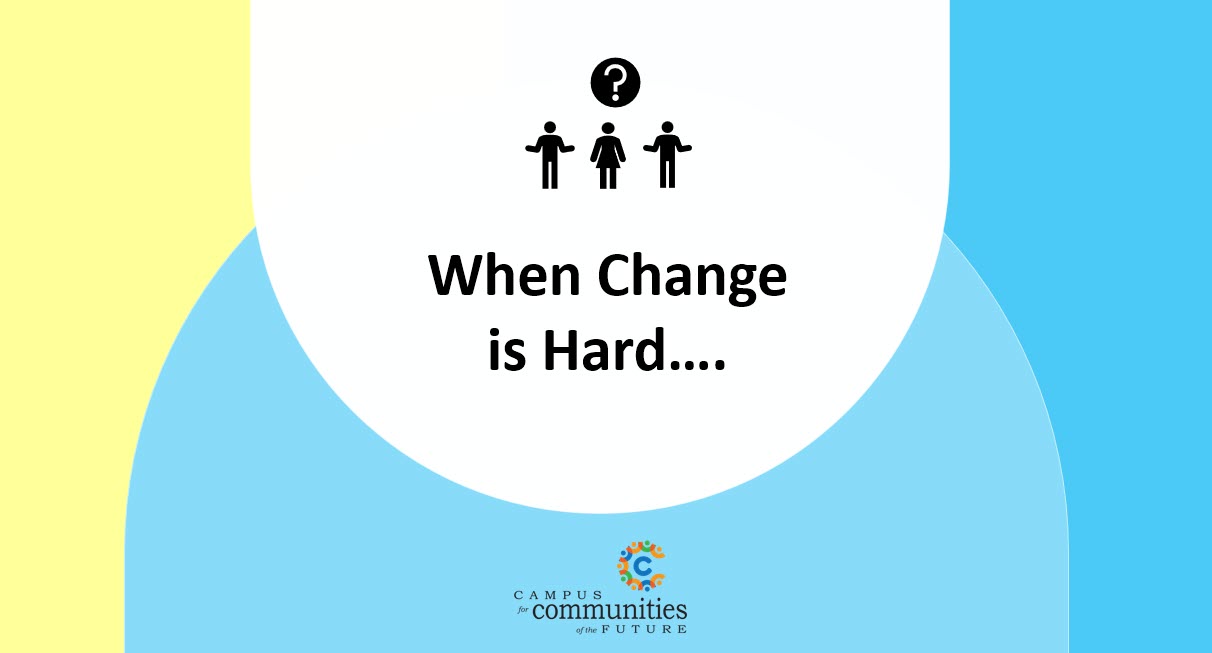When Change Feels Too Hard….

Sigh. Change is hard, especially now. Transformative, innovative change is harder. Change is overwhelmingly hard when we’re not quite sure what to do and/or are pressed for time and resources. There are many in that same boat, paddling like mad, simply to stay afloat.
The result is often a tendency to stick with what we know and stay the course. Problem is we can’t always be sure that all our paddling is sending us in the right direction. Consequently, staying the course may end up being the greatest risk of all.
On the flip side, some do the opposite. By that I mean give too much consideration to what others are doing and end up getting sidetracked or distracted. I’m one of those. Or, maybe I just have a short attention span and drink too much coffee.
Regardless, the critical and complex issues we’re facing today in our personal, organizational, and community lives are tough puzzles to address when the path may not be as clear as we’d like.
It’s especially hard because in many cases we haven’t taken time to grieve the tangible and intangible losses resulting from Covid-19. Additionally, even if there is a picture on the top of the puzzle box providing a clearer picture for moving forward, the new picture may require puzzle pieces we may not have.

As a result, know there are many of us struggling to find a way forward because (1) people aren’t created as separate departments but our systems are designed as if they were, (2) complex challenges rarely fit within one silo, and/or (3) we may not have the how-to’s for navigating a to a better future when the path is dimly lit.
I’ve found thinking about change as it was described by William Bridges can be helpful, particularly as Covid-19 has for many meant ‘an ending that needs a new beginning’.
Some 30+ plus years ago, he described the process of change as transitioning through three distinct phases:
1. the ending of the old approach or system (letting go);
2. the neutral zone (when the old has been dismissed, but the new has yet to be fully implemented), and;
3. the beginning of the new.
As he explained it, change begins with an ending and ends with a beginning – each requires different strategies and support. Covid-19 in combination with a rapidly changing world has meant that for many there is a need to be supported as (1) we grieve and let go, (2) deal with the uncertainty of the neutral zone, and (3) transition to a new approach or system.
Getting through those three stages also requires:
• kindness, empathy, and patience with ourselves and one another;
• a willingness to accept we likely won’t have all the answers and will be better off if we have the courage to tap the collective wisdom of others;
• access to adequate resources of time and money for training, resources, and ongoing support and development;
• continuous, transparent and authentic communication;
• feeling it is safe to change. Generally, according to the Pareto Principle (also known as the 80-20 rule), roughly 80 percent of the effects come from 20 percent of the causes. Typically, that means the change that needs to happen in our lives, organizations, businesses, and communities is less than 20 percent. Knowing that 80 percent of what we’re doing may be okay, and that we’re only talking about addressing 20 percent, can make the idea of change less intimidating and feel safer;
• managing expectations, our own as well as those of others will be critical. It’s similar to the pilot on the plane who tells us to put our seatbelts on because we’re about to enter some turbulence. In other words, we need to be clear up front that we’re in for a bumpy ride when change is expected. If we know and acknowledge, or are told to expect it to be rough, it never seems quite as bad as we had anticipated;
• we can also prioritize transferring the knowledge that will help ourselves as well as others believe, unlearn, and relearn new things. This can be done by working at gathering and sharing new resources, promising practices, and inspirational stories;
• we also know that behaviour is more likely to change if people’s feelings are prioritized. Consequently, change can be more effectively supported if we find ways for ourselves and others to see challenges or solutions in ways that will influence emotions as well as behaviours. For example, ask “How does that make you feel? or Why am I feeling this way?”;
• stories are important. For example, as Deutschman illustrated in his book Change or Die, in the case of cardiac patients, providing information about healthier lifestyles is important but motivating by fear of death simply doesn’t work (a mere 10 percent will find that to be motivating). By the same token, a new and inspiring vision for an organization or community will be a more powerful motivator than the fear of a downturn in economic growth. Facts alone can’t change the mindsets or frameworks we hold. However, the reality is that getting people to exchange one mindset for another is challenging. What works most effectively are stories that are simple, easy to identify with, and are emotionally meaningful suggesting positive experiences.
Once a need for change has been embraced, it is important to frame it for success. This is a challenge for everyone especially as it seems inevitable that the need for change always seems to occur at the busiest, most stressful times when emotions are running close to the surface.
Also, keep in mind yet another finding. Recent research has suggested comprehensive changes are often easier for some people than small incremental ones.
We all need to do our best to stay focused and convey a positive message. It may also mean continuing to restate something you see as implicit or quite obvious because for many it won’t be as apparent.
While these new strategies can be applied to supporting change with individuals, organizations, and entire communities, adding an element of fun and celebrating small wins can also be magical ingredients.
Most importantly, we all need to keep working to embrace the idea that if we don’t like what’s going on in our life, organizations, or in our communities, ultimately it is up to us to initiate the change we want to see. If we don’t, someone else will do it for us and we might not like the results.
Next entry: They Ran to Help
Previous entry: Finally I have a Category

 Brenda Herchmer is the owner of Grassroots Enterprises, a community development consulting company.
Brenda Herchmer is the owner of Grassroots Enterprises, a community development consulting company.